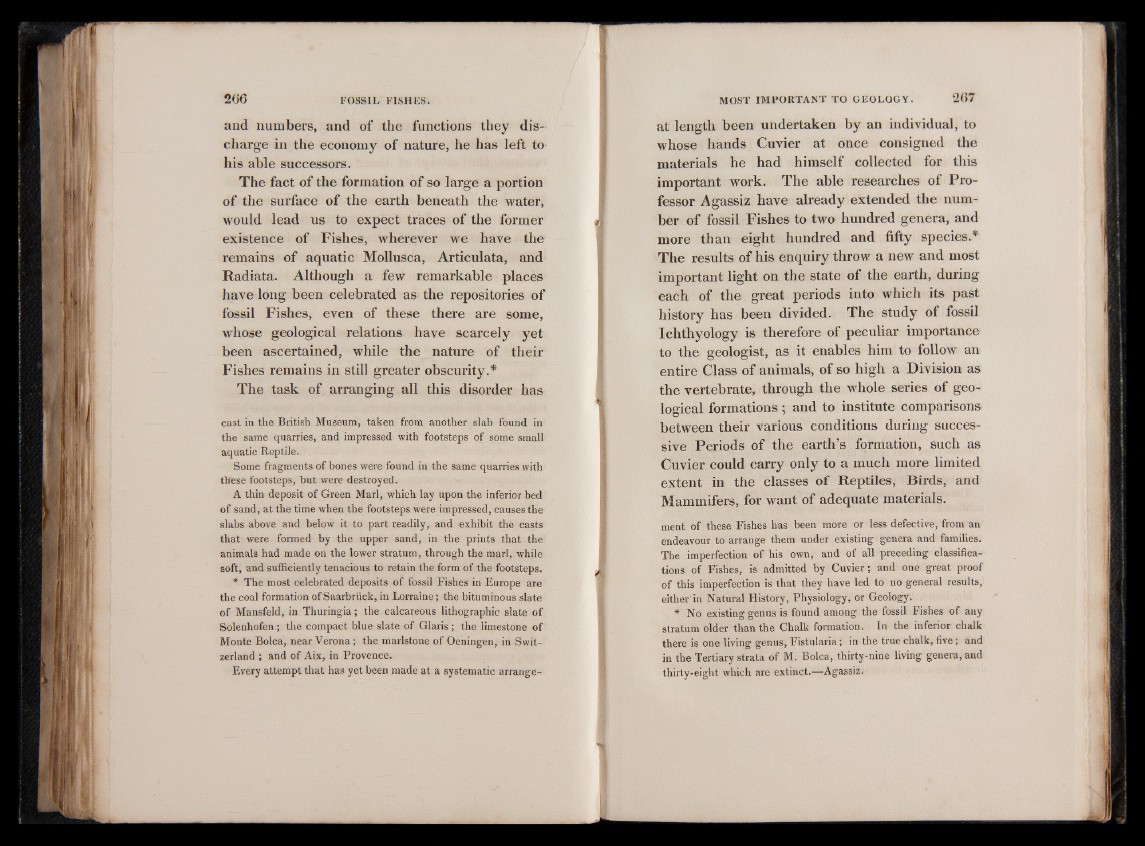
and numbers, and of the functions they discharge
in the economy of nature, he has left to
his able successors.
The fact of the formation of so large a portion
of the surface of the earth beneath the water,
would lead us to expect traces of the former
existence of Fishes, wherever we have the
remains of aquatic Mollusca, Articulata, and
Radiata. Although a few remarkable places
have long been celebrated as the repositories of
fossil Fishes, even of these there are some,
whose geological relations have scarcely yet
been ascertained, while the nature of their
Fishes remains in still greater obscurity.*
The task of arranging all this disorder has
cast in the British Museum, taken from another slab found in
the same quarries, and impressed with footsteps of some small
aquatic Reptile.
Some fragments of bones were found in the same quarries with
these footsteps, but were destroyed.
A thin deposit of Green Marl, which lay upon the inferior bed
of sand, at the time when the footsteps were impressed, causes the
slabs above and below it to part readily, and exhibit the casts
that were formed by the upper sand, in the prints that the
animals had made on the lower stratum, through the marl, while
soft, and sufficiently tenacious to retain the form of the footsteps.
* The most celebrated deposits of fossil Fishes in Europe are
the coal formation of Saarbriick, in Lorraine; the bituminous slate
of Mansfeld, in Thuringia; the calcareous lithographic slate of
Solenhofen; the compact blue slate of Glaris; the limestone of
Monte Bolca, near Verona; the marlstone of Oeningen, in Switzerland
; and of Aix, in Provence.
Every attempt that has yet been made at a systematic arrangeat
length been undertaken by an individual, to
whose hands Cuvier at once consigned the
materials he had himself collected for this
important work. The able researches of Professor
Agassiz have already extended the number
of fossil Fishes to two hundred genera, and
more than eight hundred and fifty species*
The results of his enquiry throw a new and most
important light on the state of the earth, during
each of the great periods into which its past
history has been divided. The study of fossil
Ichthyology is therefore of peculiar importance
to the geologist, as it enables him to follow an
entire Class of animals, of so high a Division as
the vertebrate, through the whole series of geological
formations; and to institute comparisons
between their various conditions during successive
Periods of the earth’s formation, such as
Cuvier could carry only to a much more limited
extent in the classes of Reptiles, Birds, and
Mammifers, for want of adequate materials.
ment of these Fishes has been more or less defective, from an
endeavour to arrange them under existing genera and families.
The imperfection of his own, and of all preceding classifications
of Fishes, is admitted by Cuvier; and one great proof
of this imperfection is that they have led to no general results,
either in Natural History, Physiology, or Geology.
* No existing genus is found among the fossil Fishes of any
stratum older than the Chalk formation. In the inferior chalk
there is one living genus, Fistularia; in the true chalk, five; and
in the Tertiary strata of M. Bolca, thirty-nine living genera, and
thirty-eight which are extinct.—Agassiz.